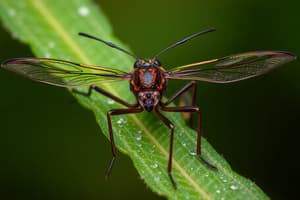Podcast
Questions and Answers
What is an example of Blattodea?
What is an example of Blattodea?
- Flies and mosquitoes
- Cockroaches (correct)
- Beetles
- Earwigs
What is an example of Coleoptera?
What is an example of Coleoptera?
- Cockroaches
- Earwigs
- All beetles (correct)
- Flies and mosquitoes
What is an example of Dermaptera?
What is an example of Dermaptera?
- Moths
- Beetles
- Flies
- Earwigs (correct)
What is an example of Diptera?
What is an example of Diptera?
What is an example of Hemiptera?
What is an example of Hemiptera?
What is an example of Hymenoptera?
What is an example of Hymenoptera?
What is an example of Isoptera?
What is an example of Isoptera?
What is an example of Lepidoptera?
What is an example of Lepidoptera?
What is an example of Odonata?
What is an example of Odonata?
What is an example of Orthoptera?
What is an example of Orthoptera?
What is an example of Phasmida?
What is an example of Phasmida?
What is an example of Siphonaptera?
What is an example of Siphonaptera?
What is an example of Trichoptera?
What is an example of Trichoptera?
Flashcards are hidden until you start studying
Study Notes
Insect Orders and Examples
-
Blattodea: Includes cockroaches, known for their flattened bodies and long antennae; they are often seen as pests in urban environments.
-
Coleoptera: Comprises all beetles, the largest order of insects, characterized by hardened forewings and diverse habitats.
-
Dermaptera: Represents earwigs, identifiable by their pincers or cerci at the rear, they primarily feed on decaying organic matter.
-
Diptera: Encompasses flies and mosquitoes, distinguished by their single pair of wings and significant roles in ecosystems and disease transmission.
-
Hemiptera: Features bed bugs and other "true bugs," known for their piercing mouthparts and role in agriculture as pests.
-
Hymenoptera: Includes ants, bees, and wasps, important for pollination and social behavior in colonies; some species are crucial for ecosystems.
-
Isoptera: Refers to termites, known for their wood-consuming habits and complex social structures, play vital roles in decomposition.
-
Lepidoptera: Comprises moths and butterflies, recognized for their scale-covered wings and life cycles that include metamorphosis.
-
Odonata: Includes dragonflies and damselflies, known for their agile aerial abilities and ecological significance as predators of other insects.
-
Orthoptera: Contains katydids, grasshoppers, and crickets, recognized for their jumping abilities and distinctive sounds produced by stridulation.
-
Phasmida: Encompasses stick insects, noted for their camouflage that mimics twigs or leaves, aiding in predator avoidance.
-
Siphonaptera: Represents fleas, parasites known for their jumping abilities and impact on both wild and domesticated animals.
-
Trichoptera: Comprises caddisflies, associated with aquatic habitats, known for their larvae that build protective cases from debris.
Studying That Suits You
Use AI to generate personalized quizzes and flashcards to suit your learning preferences.




